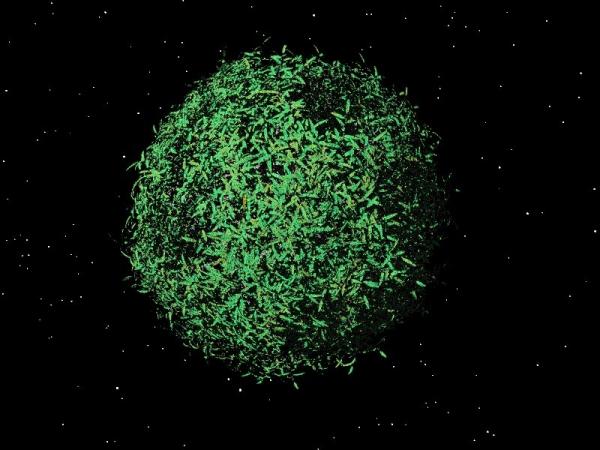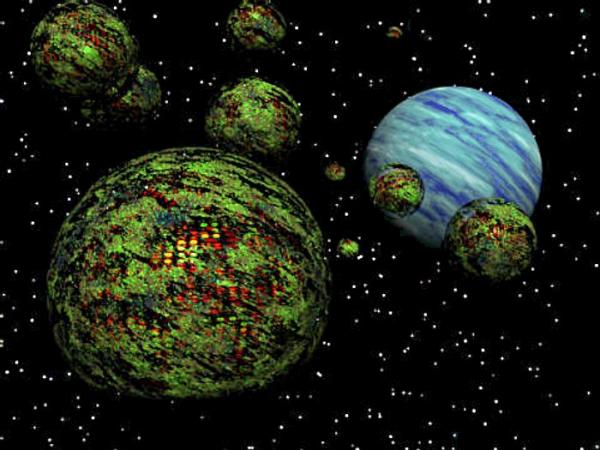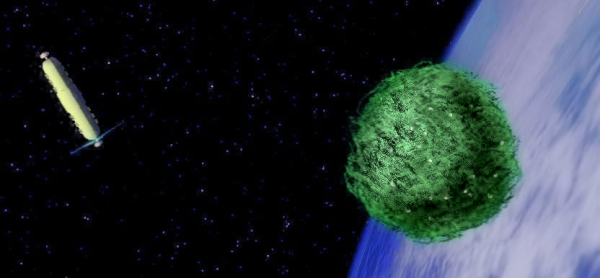BY LETTER
Dyson Trees
Technology > Technology Type or Material > Gengineering
Technology > Technology Levels > High Tech / Hitech
Technology > Application > Infrastructure
Technology > Application > Megascale Engineering
Technology > Technology Type or Material > Nanotech
Technology > Technology Type or Material > Organic/Biotech
Technology > Technology Levels > High Tech / Hitech
Technology > Application > Infrastructure
Technology > Application > Megascale Engineering
Technology > Technology Type or Material > Nanotech
Technology > Technology Type or Material > Organic/Biotech
 Image from Anders Sandberg | |
| The Dyson Tree at Jambori, Nuicrick Plexus, Zoeific Biopolity. This relatively young tree is as yet sparsely populated, and does not show the massive hab development, utility fog wisps, and shuttle traffic characteristic of the more densely inhabited trees. | |
Growth of a new tree begins when a suitable comet is diverted into a close solar orbit and a seed is planted on it. Over several years the seed extends a root system into and around the comet and then begins the growth of the primary trunk systems. Depending on the material supply in the comet and the distance from the star, full growth may take up to a century. However, most trees are ready for initial habitation within 10 years of planting. Average tree lifetimes run to a millennium even without life-extension bio-nano, and a mature tree may support a population in the millions.
In systems where the trees have been long established entire 'orbital forests', consisting of hundreds of trees spread across millions of cubic kilometers, may be found in the most desirable orbits.
 Image from Todd Drashner | |
| A forest of Orwood class Dyson Trees | |
History
The first experimental dyson trees date from as early as the Middle Interplanetary period. Unfortunately, none of the early trees survived the Technocalypse.The idea was however popular enough to be taken up again by the First Federation, with diverted a number of comet cores from the Oort Belt. Unfortunately, many of these cores had already been long populated by haloist clades, and most either wouldn't give up their cores, or did so only after exorbitant financial remuneration. A typical cartoon from the period showed a crusty, skinny old microgravity-adapted space prospector sitting on a lump of ice, frowning, head turned away, arms and legs (prehensile feet) crossed, while slickly dressed developers in the latest Xoffona-6 suits wave wads of Fedcred in eir face.
Tree-based development projects only really took off during the Age of Expansion, supported by clades of spacers and biotech megacorps.
These days dyson trees are very popular in the Zoeific Biopolity, the Utopia Sphere, MPA, the Negentropy Alliance, and the Sophic League. And since the seeds are relatively cheap compared to most technological solutions, and more reliable than a lot of nano, growing dyson trees has also become a common way of building a base in the Outer Volumes.
There are even wild versions of dyson trees. These propagate by sending seeds that are propelled by solar sails, chemical rockets, or even amat-propelled devices. Whole ecologies have spring up in some star systems.
Habitats
While many trees away from the Nexus in the Inner Sphere and Middle Regions, and especially the Outer Volumes, are only lightly populated, many trees in Nexus linked Inner Sphere systems are heavily populated, with a dense swarm of shuttles, ships, and other vehicles weaving among breaks in the foliage, along with docking stations, control towers, manufacturing faculties, clusters of space homes, water-filled diamondoid spheres glowing in the dark like blue pearls, others green like lush forests - little forests within a larger dyson forest - computronium banks, etc etc.There are also variants such as cyborg and bioborg trees and sub-trees - half organic and half artificial - trees that incorporate nano- and meso-fog, and innumerable other combinations. Trees which rotate to produce pseudogravity are generally known as Wagon Wheels or Cylinder Trees.
 Image from Steve Bowers | |
| Two High Cycler habitats at closest approach to Corona; a closed cylinder habitat and a 25 km orwood tree | |
The following are only a few of the many worlds and star systems that include extensive Orwoods:
- Deepwood - Deep space orwood species of probable alien origin.
- Ecotopia Dyson - includes numerous clusters of orwood forests.
- Makrania Orwoods - NoCoZo hedonics system.
- Parvati Orwood - home and origin of the Astomi.
- Phytotopia - embedded transapient orwood intelligences in the Gyanti System, affiliated with the Utopia Sphere.
- Sacredtree - Orwood Forest and system in the Zoeific Biopolity.
- The Underwoods - Orwood complex and Belts at Ao Lai (Gamma Leporis B).
Related Articles
Appears in Topics
Development Notes
Text by Todd Drashner, Anders Sandberg and M. Alan Kazlev
Initially published on 20 November 2001.
Initially published on 20 November 2001.






